Cornell CAHRS Spring 2010: Global Teams: Trends, Challenges, Solutions
VerifiedAdded on 2022/01/24
|100
|43232
|141
Report
AI Summary
This report, prepared for the Cornell Center for Advanced Human Resource Studies (CAHRS), examines the trends, challenges, and solutions related to global virtual teams. It analyzes various aspects of virtual teams, including the cost-benefit analysis of face-to-face versus virtual communication, strategies for building teams from a distance, required competencies for effective virtual leaders, the importance of developing a global mindset, challenges in monitoring and evaluating virtual team performance, and strategies for keeping remote employees engaged. The research explores the advantages and disadvantages of different communication methods, the impact of technology on team dynamics, and the importance of leadership in fostering successful virtual team collaboration. The report also includes annotated bibliographies for each topic, providing additional resources for further study.
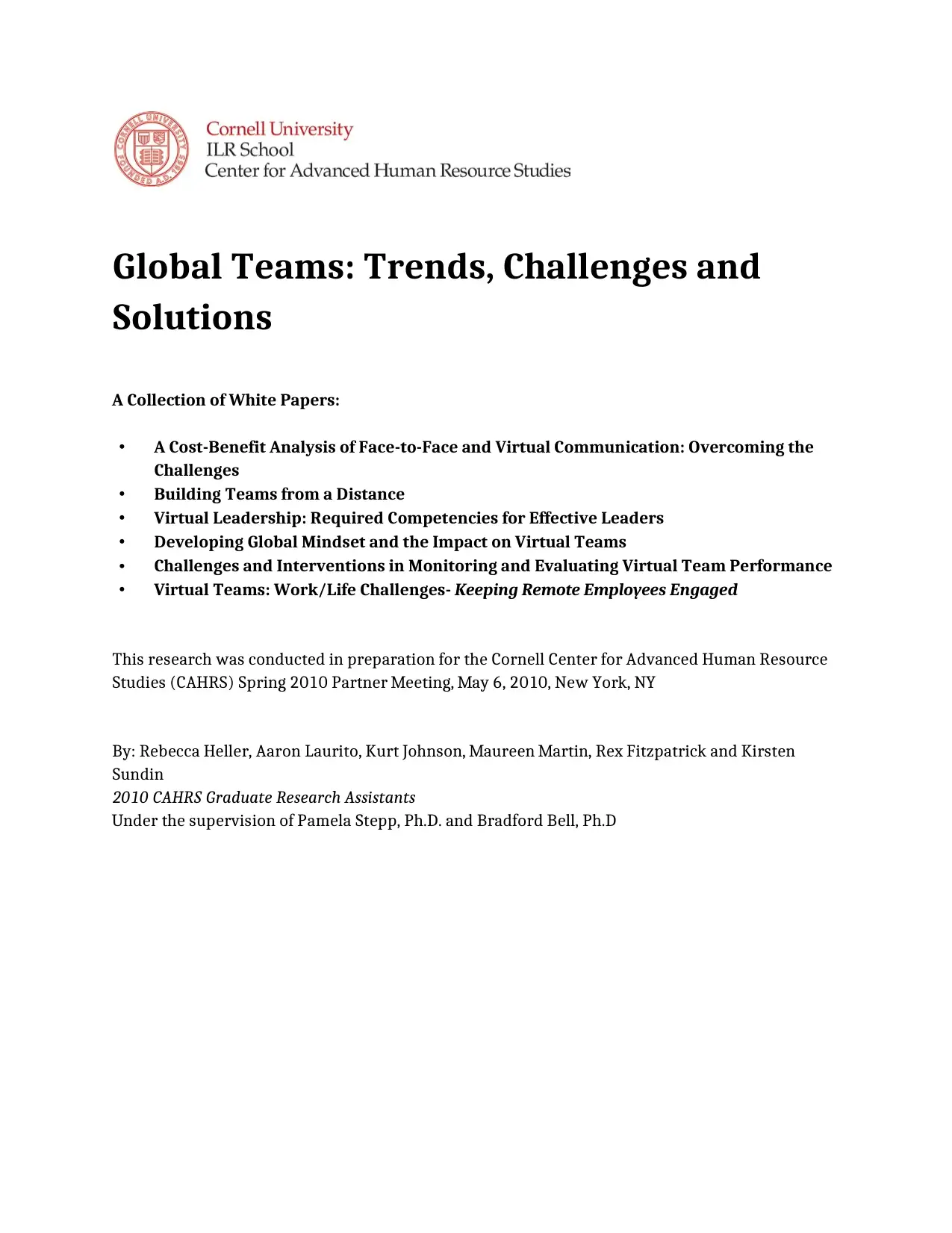
Global Teams: Trends, Challenges and
Solutions
A Collection of White Papers:
• A Cost-Benefit Analysis of Face-to-Face and Virtual Communication: Overcoming the
Challenges
• Building Teams from a Distance
• Virtual Leadership: Required Competencies for Effective Leaders
• Developing Global Mindset and the Impact on Virtual Teams
• Challenges and Interventions in Monitoring and Evaluating Virtual Team Performance
• Virtual Teams: Work/Life Challenges- Keeping Remote Employees Engaged
This research was conducted in preparation for the Cornell Center for Advanced Human Resource
Studies (CAHRS) Spring 2010 Partner Meeting, May 6, 2010, New York, NY
By: Rebecca Heller, Aaron Laurito, Kurt Johnson, Maureen Martin, Rex Fitzpatrick and Kirsten
Sundin
2010 CAHRS Graduate Research Assistants
Under the supervision of Pamela Stepp, Ph.D. and Bradford Bell, Ph.D
Solutions
A Collection of White Papers:
• A Cost-Benefit Analysis of Face-to-Face and Virtual Communication: Overcoming the
Challenges
• Building Teams from a Distance
• Virtual Leadership: Required Competencies for Effective Leaders
• Developing Global Mindset and the Impact on Virtual Teams
• Challenges and Interventions in Monitoring and Evaluating Virtual Team Performance
• Virtual Teams: Work/Life Challenges- Keeping Remote Employees Engaged
This research was conducted in preparation for the Cornell Center for Advanced Human Resource
Studies (CAHRS) Spring 2010 Partner Meeting, May 6, 2010, New York, NY
By: Rebecca Heller, Aaron Laurito, Kurt Johnson, Maureen Martin, Rex Fitzpatrick and Kirsten
Sundin
2010 CAHRS Graduate Research Assistants
Under the supervision of Pamela Stepp, Ph.D. and Bradford Bell, Ph.D
Paraphrase This Document
Need a fresh take? Get an instant paraphrase of this document with our AI Paraphraser

2
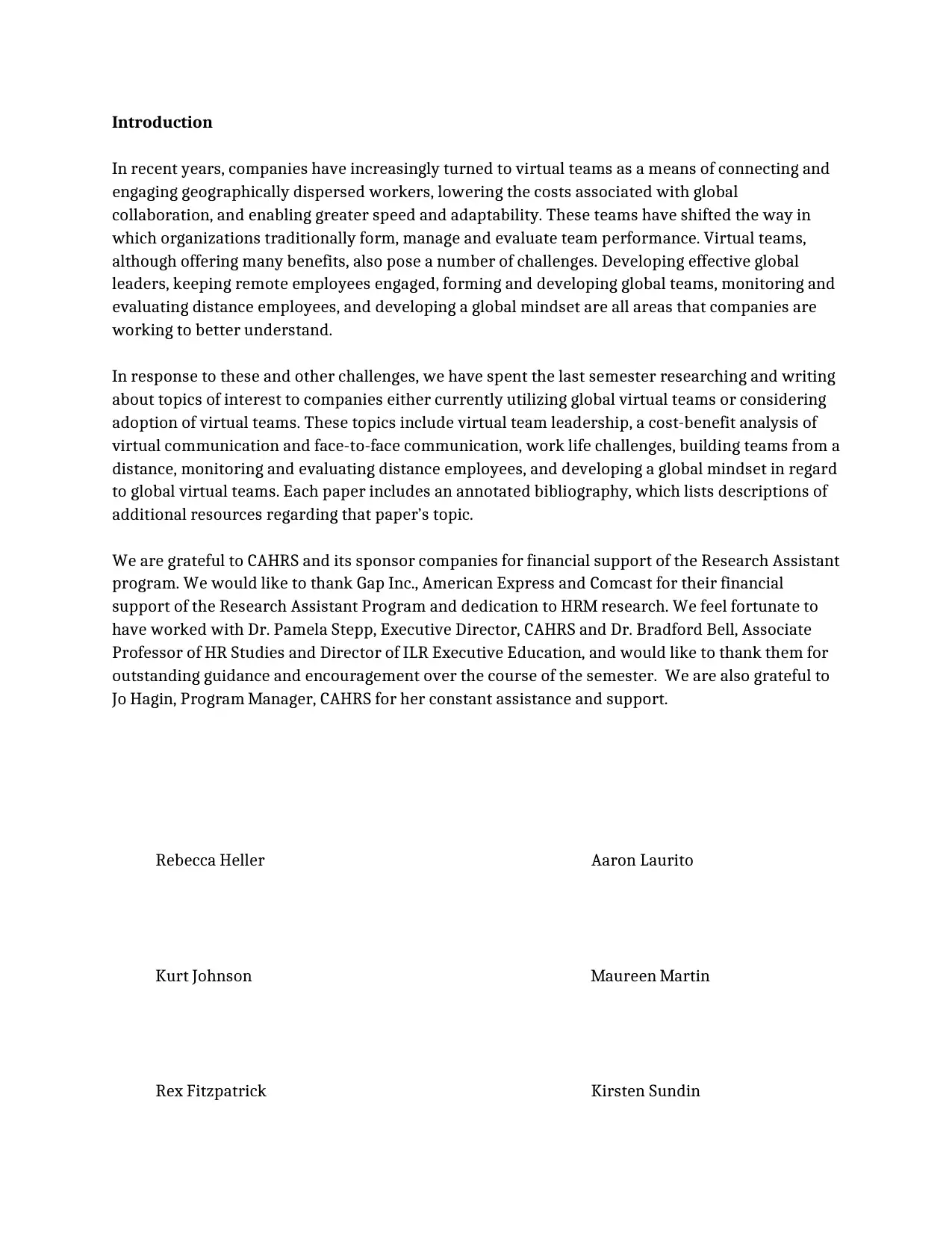
Introduction
In recent years, companies have increasingly turned to virtual teams as a means of connecting and
engaging geographically dispersed workers, lowering the costs associated with global
collaboration, and enabling greater speed and adaptability. These teams have shifted the way in
which organizations traditionally form, manage and evaluate team performance. Virtual teams,
although offering many benefits, also pose a number of challenges. Developing effective global
leaders, keeping remote employees engaged, forming and developing global teams, monitoring and
evaluating distance employees, and developing a global mindset are all areas that companies are
working to better understand.
In response to these and other challenges, we have spent the last semester researching and writing
about topics of interest to companies either currently utilizing global virtual teams or considering
adoption of virtual teams. These topics include virtual team leadership, a cost-benefit analysis of
virtual communication and face-to-face communication, work life challenges, building teams from a
distance, monitoring and evaluating distance employees, and developing a global mindset in regard
to global virtual teams. Each paper includes an annotated bibliography, which lists descriptions of
additional resources regarding that paper’s topic.
We are grateful to CAHRS and its sponsor companies for financial support of the Research Assistant
program. We would like to thank Gap Inc., American Express and Comcast for their financial
support of the Research Assistant Program and dedication to HRM research. We feel fortunate to
have worked with Dr. Pamela Stepp, Executive Director, CAHRS and Dr. Bradford Bell, Associate
Professor of HR Studies and Director of ILR Executive Education, and would like to thank them for
outstanding guidance and encouragement over the course of the semester. We are also grateful to
Jo Hagin, Program Manager, CAHRS for her constant assistance and support.
Rebecca Heller Aaron Laurito
Kurt Johnson Maureen Martin
Rex Fitzpatrick Kirsten Sundin
In recent years, companies have increasingly turned to virtual teams as a means of connecting and
engaging geographically dispersed workers, lowering the costs associated with global
collaboration, and enabling greater speed and adaptability. These teams have shifted the way in
which organizations traditionally form, manage and evaluate team performance. Virtual teams,
although offering many benefits, also pose a number of challenges. Developing effective global
leaders, keeping remote employees engaged, forming and developing global teams, monitoring and
evaluating distance employees, and developing a global mindset are all areas that companies are
working to better understand.
In response to these and other challenges, we have spent the last semester researching and writing
about topics of interest to companies either currently utilizing global virtual teams or considering
adoption of virtual teams. These topics include virtual team leadership, a cost-benefit analysis of
virtual communication and face-to-face communication, work life challenges, building teams from a
distance, monitoring and evaluating distance employees, and developing a global mindset in regard
to global virtual teams. Each paper includes an annotated bibliography, which lists descriptions of
additional resources regarding that paper’s topic.
We are grateful to CAHRS and its sponsor companies for financial support of the Research Assistant
program. We would like to thank Gap Inc., American Express and Comcast for their financial
support of the Research Assistant Program and dedication to HRM research. We feel fortunate to
have worked with Dr. Pamela Stepp, Executive Director, CAHRS and Dr. Bradford Bell, Associate
Professor of HR Studies and Director of ILR Executive Education, and would like to thank them for
outstanding guidance and encouragement over the course of the semester. We are also grateful to
Jo Hagin, Program Manager, CAHRS for her constant assistance and support.
Rebecca Heller Aaron Laurito
Kurt Johnson Maureen Martin
Rex Fitzpatrick Kirsten Sundin
⊘ This is a preview!⊘
Do you want full access?
Subscribe today to unlock all pages.

Trusted by 1+ million students worldwide

4
Paraphrase This Document
Need a fresh take? Get an instant paraphrase of this document with our AI Paraphraser
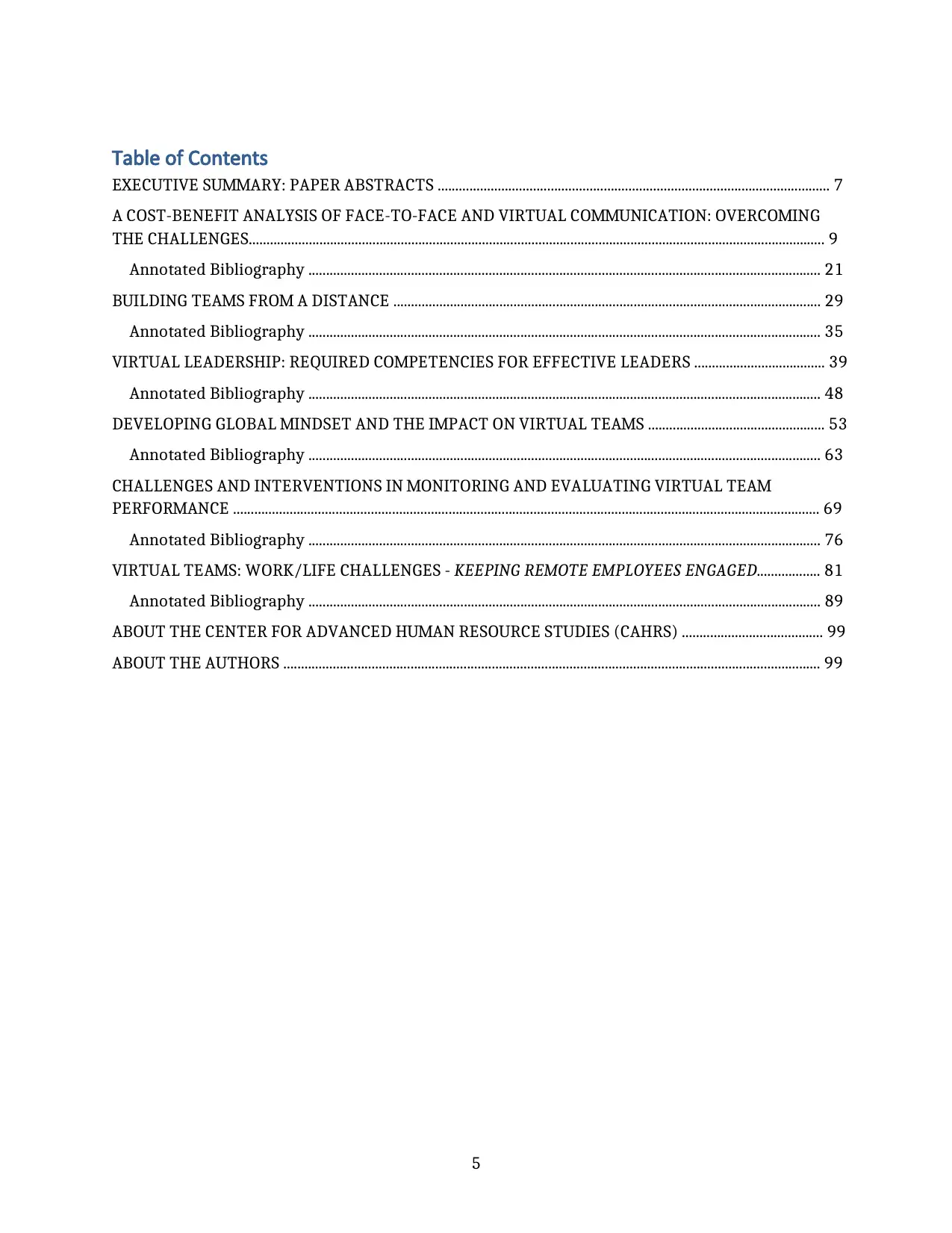
5
Table of Contents
EXECUTIVE SUMMARY: PAPER ABSTRACTS ............................................................................................................... 7
A COST-BENEFIT ANALYSIS OF FACE-TO-FACE AND VIRTUAL COMMUNICATION: OVERCOMING
THE CHALLENGES................................................................................................................................................................... 9
Annotated Bibliography ................................................................................................................................................. 21
BUILDING TEAMS FROM A DISTANCE ......................................................................................................................... 29
Annotated Bibliography ................................................................................................................................................. 35
VIRTUAL LEADERSHIP: REQUIRED COMPETENCIES FOR EFFECTIVE LEADERS ..................................... 39
Annotated Bibliography ................................................................................................................................................. 48
DEVELOPING GLOBAL MINDSET AND THE IMPACT ON VIRTUAL TEAMS .................................................. 53
Annotated Bibliography ................................................................................................................................................. 63
CHALLENGES AND INTERVENTIONS IN MONITORING AND EVALUATING VIRTUAL TEAM
PERFORMANCE ...................................................................................................................................................................... 69
Annotated Bibliography ................................................................................................................................................. 76
VIRTUAL TEAMS: WORK/LIFE CHALLENGES - KEEPING REMOTE EMPLOYEES ENGAGED.................. 81
Annotated Bibliography ................................................................................................................................................. 89
ABOUT THE CENTER FOR ADVANCED HUMAN RESOURCE STUDIES (CAHRS) ........................................ 99
ABOUT THE AUTHORS ........................................................................................................................................................ 99
Table of Contents
EXECUTIVE SUMMARY: PAPER ABSTRACTS ............................................................................................................... 7
A COST-BENEFIT ANALYSIS OF FACE-TO-FACE AND VIRTUAL COMMUNICATION: OVERCOMING
THE CHALLENGES................................................................................................................................................................... 9
Annotated Bibliography ................................................................................................................................................. 21
BUILDING TEAMS FROM A DISTANCE ......................................................................................................................... 29
Annotated Bibliography ................................................................................................................................................. 35
VIRTUAL LEADERSHIP: REQUIRED COMPETENCIES FOR EFFECTIVE LEADERS ..................................... 39
Annotated Bibliography ................................................................................................................................................. 48
DEVELOPING GLOBAL MINDSET AND THE IMPACT ON VIRTUAL TEAMS .................................................. 53
Annotated Bibliography ................................................................................................................................................. 63
CHALLENGES AND INTERVENTIONS IN MONITORING AND EVALUATING VIRTUAL TEAM
PERFORMANCE ...................................................................................................................................................................... 69
Annotated Bibliography ................................................................................................................................................. 76
VIRTUAL TEAMS: WORK/LIFE CHALLENGES - KEEPING REMOTE EMPLOYEES ENGAGED.................. 81
Annotated Bibliography ................................................................................................................................................. 89
ABOUT THE CENTER FOR ADVANCED HUMAN RESOURCE STUDIES (CAHRS) ........................................ 99
ABOUT THE AUTHORS ........................................................................................................................................................ 99

6
⊘ This is a preview!⊘
Do you want full access?
Subscribe today to unlock all pages.

Trusted by 1+ million students worldwide
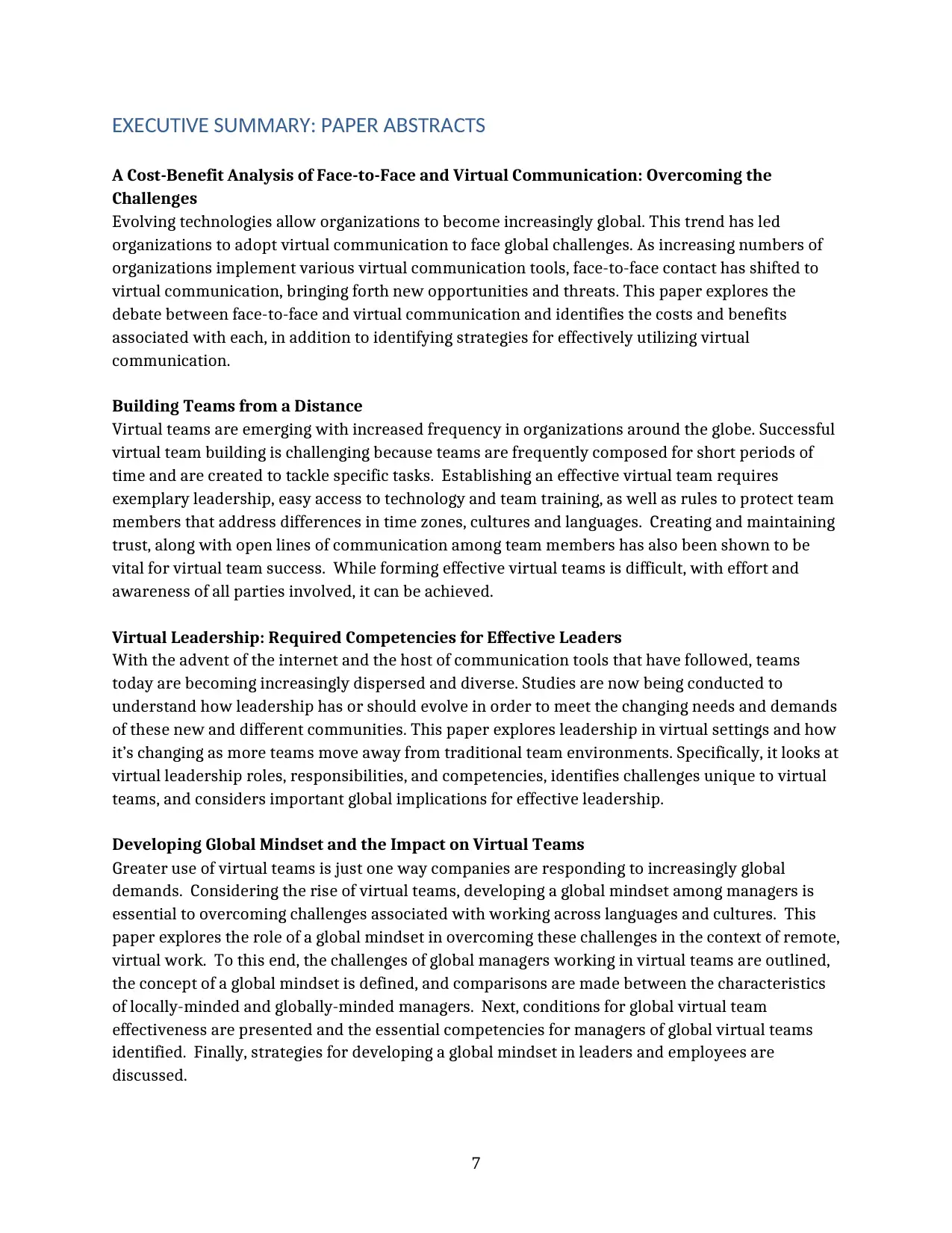
7
C T MM T CTEXE U IVE SU ARY: PAPER ABS RA S
A Cost-Benefit Analysis of Face-to-Face and Virtual Communication: Overcoming the
Challenges
Evolving technologies allow organizations to become increasingly global. This trend has led
organizations to adopt virtual communication to face global challenges. As increasing numbers of
organizations implement various virtual communication tools, face-to-face contact has shifted to
virtual communication, bringing forth new opportunities and threats. This paper explores the
debate between face-to-face and virtual communication and identifies the costs and benefits
associated with each, in addition to identifying strategies for effectively utilizing virtual
communication.
Building Teams from a Distance
Virtual teams are emerging with increased frequency in organizations around the globe. Successful
virtual team building is challenging because teams are frequently composed for short periods of
time and are created to tackle specific tasks. Establishing an effective virtual team requires
exemplary leadership, easy access to technology and team training, as well as rules to protect team
members that address differences in time zones, cultures and languages. Creating and maintaining
trust, along with open lines of communication among team members has also been shown to be
vital for virtual team success. While forming effective virtual teams is difficult, with effort and
awareness of all parties involved, it can be achieved.
Virtual Leadership: Required Competencies for Effective Leaders
With the advent of the internet and the host of communication tools that have followed, teams
today are becoming increasingly dispersed and diverse. Studies are now being conducted to
understand how leadership has or should evolve in order to meet the changing needs and demands
of these new and different communities. This paper explores leadership in virtual settings and how
it’s changing as more teams move away from traditional team environments. Specifically, it looks at
virtual leadership roles, responsibilities, and competencies, identifies challenges unique to virtual
teams, and considers important global implications for effective leadership.
Developing Global Mindset and the Impact on Virtual Teams
Greater use of virtual teams is just one way companies are responding to increasingly global
demands. Considering the rise of virtual teams, developing a global mindset among managers is
essential to overcoming challenges associated with working across languages and cultures. This
paper explores the role of a global mindset in overcoming these challenges in the context of remote,
virtual work. To this end, the challenges of global managers working in virtual teams are outlined,
the concept of a global mindset is defined, and comparisons are made between the characteristics
of locally-minded and globally-minded managers. Next, conditions for global virtual team
effectiveness are presented and the essential competencies for managers of global virtual teams
identified. Finally, strategies for developing a global mindset in leaders and employees are
discussed.
C T MM T CTEXE U IVE SU ARY: PAPER ABS RA S
A Cost-Benefit Analysis of Face-to-Face and Virtual Communication: Overcoming the
Challenges
Evolving technologies allow organizations to become increasingly global. This trend has led
organizations to adopt virtual communication to face global challenges. As increasing numbers of
organizations implement various virtual communication tools, face-to-face contact has shifted to
virtual communication, bringing forth new opportunities and threats. This paper explores the
debate between face-to-face and virtual communication and identifies the costs and benefits
associated with each, in addition to identifying strategies for effectively utilizing virtual
communication.
Building Teams from a Distance
Virtual teams are emerging with increased frequency in organizations around the globe. Successful
virtual team building is challenging because teams are frequently composed for short periods of
time and are created to tackle specific tasks. Establishing an effective virtual team requires
exemplary leadership, easy access to technology and team training, as well as rules to protect team
members that address differences in time zones, cultures and languages. Creating and maintaining
trust, along with open lines of communication among team members has also been shown to be
vital for virtual team success. While forming effective virtual teams is difficult, with effort and
awareness of all parties involved, it can be achieved.
Virtual Leadership: Required Competencies for Effective Leaders
With the advent of the internet and the host of communication tools that have followed, teams
today are becoming increasingly dispersed and diverse. Studies are now being conducted to
understand how leadership has or should evolve in order to meet the changing needs and demands
of these new and different communities. This paper explores leadership in virtual settings and how
it’s changing as more teams move away from traditional team environments. Specifically, it looks at
virtual leadership roles, responsibilities, and competencies, identifies challenges unique to virtual
teams, and considers important global implications for effective leadership.
Developing Global Mindset and the Impact on Virtual Teams
Greater use of virtual teams is just one way companies are responding to increasingly global
demands. Considering the rise of virtual teams, developing a global mindset among managers is
essential to overcoming challenges associated with working across languages and cultures. This
paper explores the role of a global mindset in overcoming these challenges in the context of remote,
virtual work. To this end, the challenges of global managers working in virtual teams are outlined,
the concept of a global mindset is defined, and comparisons are made between the characteristics
of locally-minded and globally-minded managers. Next, conditions for global virtual team
effectiveness are presented and the essential competencies for managers of global virtual teams
identified. Finally, strategies for developing a global mindset in leaders and employees are
discussed.
Paraphrase This Document
Need a fresh take? Get an instant paraphrase of this document with our AI Paraphraser
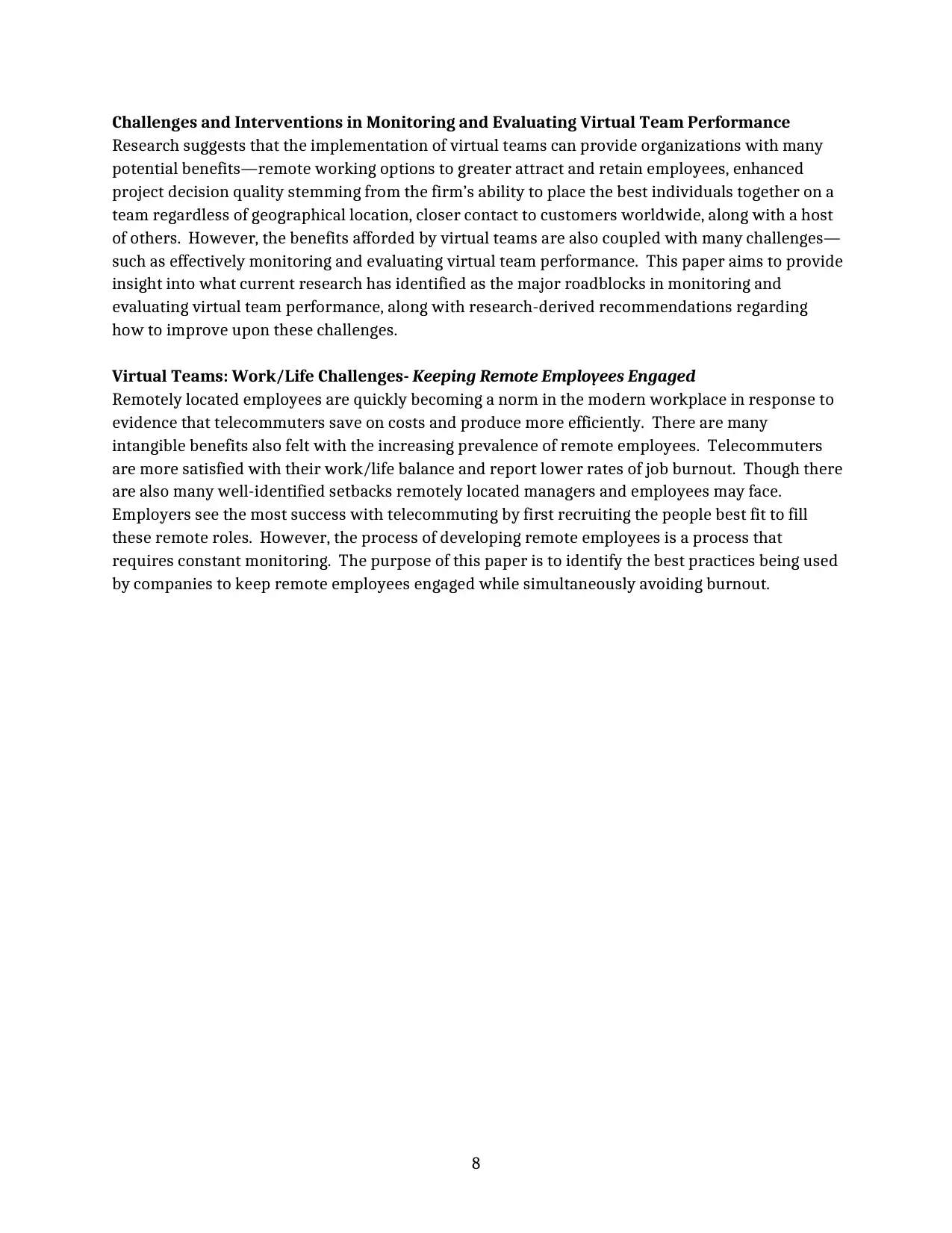
8
Challenges and Interventions in Monitoring and Evaluating Virtual Team Performance
Research suggests that the implementation of virtual teams can provide organizations with many
potential benefits—remote working options to greater attract and retain employees, enhanced
project decision quality stemming from the firm’s ability to place the best individuals together on a
team regardless of geographical location, closer contact to customers worldwide, along with a host
of others. However, the benefits afforded by virtual teams are also coupled with many challenges—
such as effectively monitoring and evaluating virtual team performance. This paper aims to provide
insight into what current research has identified as the major roadblocks in monitoring and
evaluating virtual team performance, along with research-derived recommendations regarding
how to improve upon these challenges.
Virtual Teams: Work/Life Challenges- Keeping Remote Employees Engaged
Remotely located employees are quickly becoming a norm in the modern workplace in response to
evidence that telecommuters save on costs and produce more efficiently. There are many
intangible benefits also felt with the increasing prevalence of remote employees. Telecommuters
are more satisfied with their work/life balance and report lower rates of job burnout. Though there
are also many well-identified setbacks remotely located managers and employees may face.
Employers see the most success with telecommuting by first recruiting the people best fit to fill
these remote roles. However, the process of developing remote employees is a process that
requires constant monitoring. The purpose of this paper is to identify the best practices being used
by companies to keep remote employees engaged while simultaneously avoiding burnout.
Challenges and Interventions in Monitoring and Evaluating Virtual Team Performance
Research suggests that the implementation of virtual teams can provide organizations with many
potential benefits—remote working options to greater attract and retain employees, enhanced
project decision quality stemming from the firm’s ability to place the best individuals together on a
team regardless of geographical location, closer contact to customers worldwide, along with a host
of others. However, the benefits afforded by virtual teams are also coupled with many challenges—
such as effectively monitoring and evaluating virtual team performance. This paper aims to provide
insight into what current research has identified as the major roadblocks in monitoring and
evaluating virtual team performance, along with research-derived recommendations regarding
how to improve upon these challenges.
Virtual Teams: Work/Life Challenges- Keeping Remote Employees Engaged
Remotely located employees are quickly becoming a norm in the modern workplace in response to
evidence that telecommuters save on costs and produce more efficiently. There are many
intangible benefits also felt with the increasing prevalence of remote employees. Telecommuters
are more satisfied with their work/life balance and report lower rates of job burnout. Though there
are also many well-identified setbacks remotely located managers and employees may face.
Employers see the most success with telecommuting by first recruiting the people best fit to fill
these remote roles. However, the process of developing remote employees is a process that
requires constant monitoring. The purpose of this paper is to identify the best practices being used
by companies to keep remote employees engaged while simultaneously avoiding burnout.
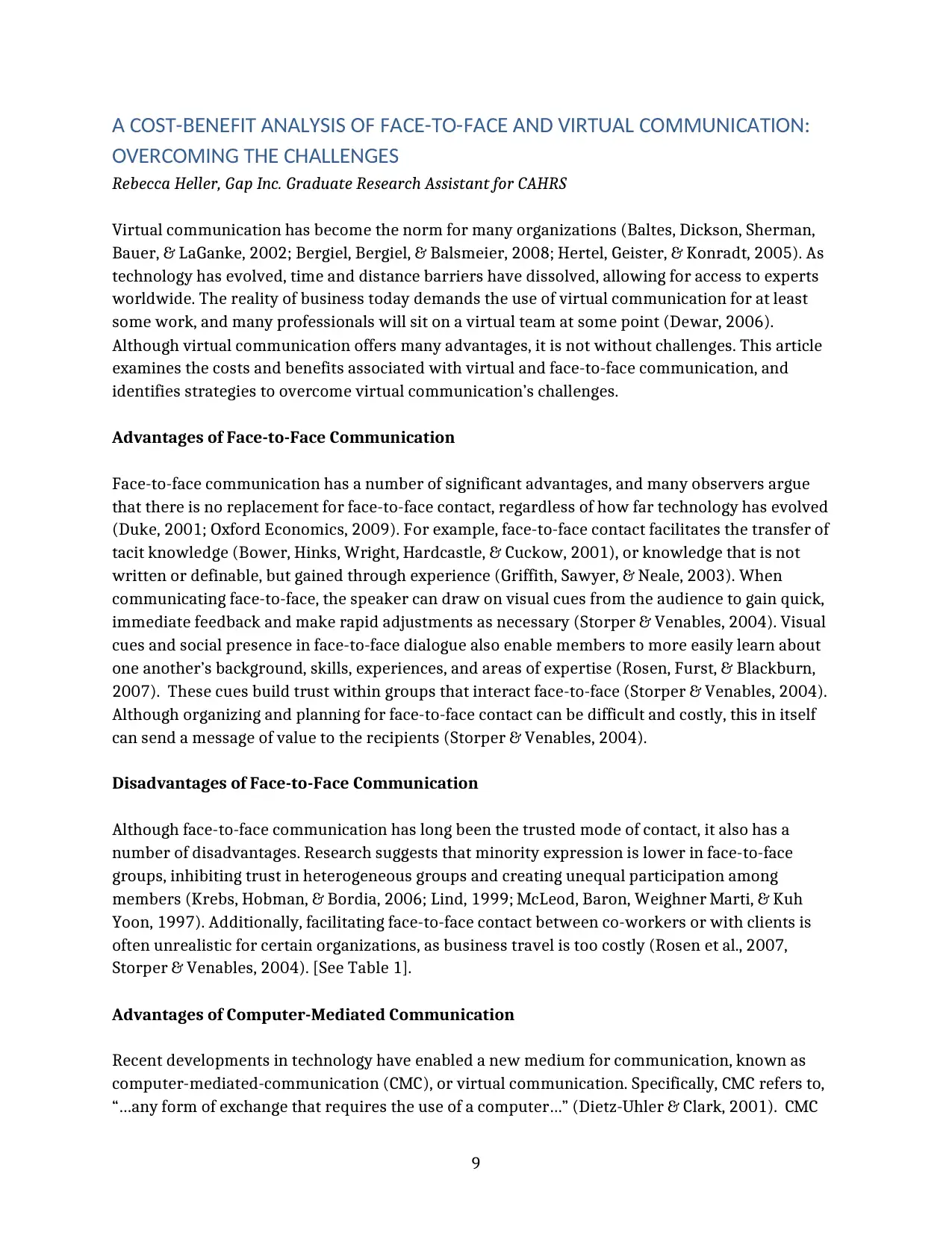
9
C T F T F F C T F C T C MM C TA OS -BENE I ANALYSIS O A E- O- A E AND VIR UAL O UNI A ION:
C M T COVER O ING HE HALLENGES
Rebecca Heller, Gap Inc. Graduate Research Assistant for CAHRS
Virtual communication has become the norm for many organizations (Baltes, Dickson, Sherman,
Bauer, & LaGanke, 2002; Bergiel, Bergiel, & Balsmeier, 2008; Hertel, Geister, & Konradt, 2005). As
technology has evolved, time and distance barriers have dissolved, allowing for access to experts
worldwide. The reality of business today demands the use of virtual communication for at least
some work, and many professionals will sit on a virtual team at some point (Dewar, 2006).
Although virtual communication offers many advantages, it is not without challenges. This article
examines the costs and benefits associated with virtual and face-to-face communication, and
identifies strategies to overcome virtual communication’s challenges.
Advantages of Face-to-Face Communication
Face-to-face communication has a number of significant advantages, and many observers argue
that there is no replacement for face-to-face contact, regardless of how far technology has evolved
(Duke, 2001; Oxford Economics, 2009). For example, face-to-face contact facilitates the transfer of
tacit knowledge (Bower, Hinks, Wright, Hardcastle, & Cuckow, 2001), or knowledge that is not
written or definable, but gained through experience (Griffith, Sawyer, & Neale, 2003). When
communicating face-to-face, the speaker can draw on visual cues from the audience to gain quick,
immediate feedback and make rapid adjustments as necessary (Storper & Venables, 2004). Visual
cues and social presence in face-to-face dialogue also enable members to more easily learn about
one another’s background, skills, experiences, and areas of expertise (Rosen, Furst, & Blackburn,
2007). These cues build trust within groups that interact face-to-face (Storper & Venables, 2004).
Although organizing and planning for face-to-face contact can be difficult and costly, this in itself
can send a message of value to the recipients (Storper & Venables, 2004).
Disadvantages of Face-to-Face Communication
Although face-to-face communication has long been the trusted mode of contact, it also has a
number of disadvantages. Research suggests that minority expression is lower in face-to-face
groups, inhibiting trust in heterogeneous groups and creating unequal participation among
members (Krebs, Hobman, & Bordia, 2006; Lind, 1999; McLeod, Baron, Weighner Marti, & Kuh
Yoon, 1997). Additionally, facilitating face-to-face contact between co-workers or with clients is
often unrealistic for certain organizations, as business travel is too costly (Rosen et al., 2007,
Storper & Venables, 2004). [See Table 1].
Advantages of Computer-Mediated Communication
Recent developments in technology have enabled a new medium for communication, known as
computer-mediated-communication (CMC), or virtual communication. Specifically, CMC refers to,
“…any form of exchange that requires the use of a computer…” (Dietz-Uhler & Clark, 2001). CMC
C T F T F F C T F C T C MM C TA OS -BENE I ANALYSIS O A E- O- A E AND VIR UAL O UNI A ION:
C M T COVER O ING HE HALLENGES
Rebecca Heller, Gap Inc. Graduate Research Assistant for CAHRS
Virtual communication has become the norm for many organizations (Baltes, Dickson, Sherman,
Bauer, & LaGanke, 2002; Bergiel, Bergiel, & Balsmeier, 2008; Hertel, Geister, & Konradt, 2005). As
technology has evolved, time and distance barriers have dissolved, allowing for access to experts
worldwide. The reality of business today demands the use of virtual communication for at least
some work, and many professionals will sit on a virtual team at some point (Dewar, 2006).
Although virtual communication offers many advantages, it is not without challenges. This article
examines the costs and benefits associated with virtual and face-to-face communication, and
identifies strategies to overcome virtual communication’s challenges.
Advantages of Face-to-Face Communication
Face-to-face communication has a number of significant advantages, and many observers argue
that there is no replacement for face-to-face contact, regardless of how far technology has evolved
(Duke, 2001; Oxford Economics, 2009). For example, face-to-face contact facilitates the transfer of
tacit knowledge (Bower, Hinks, Wright, Hardcastle, & Cuckow, 2001), or knowledge that is not
written or definable, but gained through experience (Griffith, Sawyer, & Neale, 2003). When
communicating face-to-face, the speaker can draw on visual cues from the audience to gain quick,
immediate feedback and make rapid adjustments as necessary (Storper & Venables, 2004). Visual
cues and social presence in face-to-face dialogue also enable members to more easily learn about
one another’s background, skills, experiences, and areas of expertise (Rosen, Furst, & Blackburn,
2007). These cues build trust within groups that interact face-to-face (Storper & Venables, 2004).
Although organizing and planning for face-to-face contact can be difficult and costly, this in itself
can send a message of value to the recipients (Storper & Venables, 2004).
Disadvantages of Face-to-Face Communication
Although face-to-face communication has long been the trusted mode of contact, it also has a
number of disadvantages. Research suggests that minority expression is lower in face-to-face
groups, inhibiting trust in heterogeneous groups and creating unequal participation among
members (Krebs, Hobman, & Bordia, 2006; Lind, 1999; McLeod, Baron, Weighner Marti, & Kuh
Yoon, 1997). Additionally, facilitating face-to-face contact between co-workers or with clients is
often unrealistic for certain organizations, as business travel is too costly (Rosen et al., 2007,
Storper & Venables, 2004). [See Table 1].
Advantages of Computer-Mediated Communication
Recent developments in technology have enabled a new medium for communication, known as
computer-mediated-communication (CMC), or virtual communication. Specifically, CMC refers to,
“…any form of exchange that requires the use of a computer…” (Dietz-Uhler & Clark, 2001). CMC
⊘ This is a preview!⊘
Do you want full access?
Subscribe today to unlock all pages.

Trusted by 1+ million students worldwide
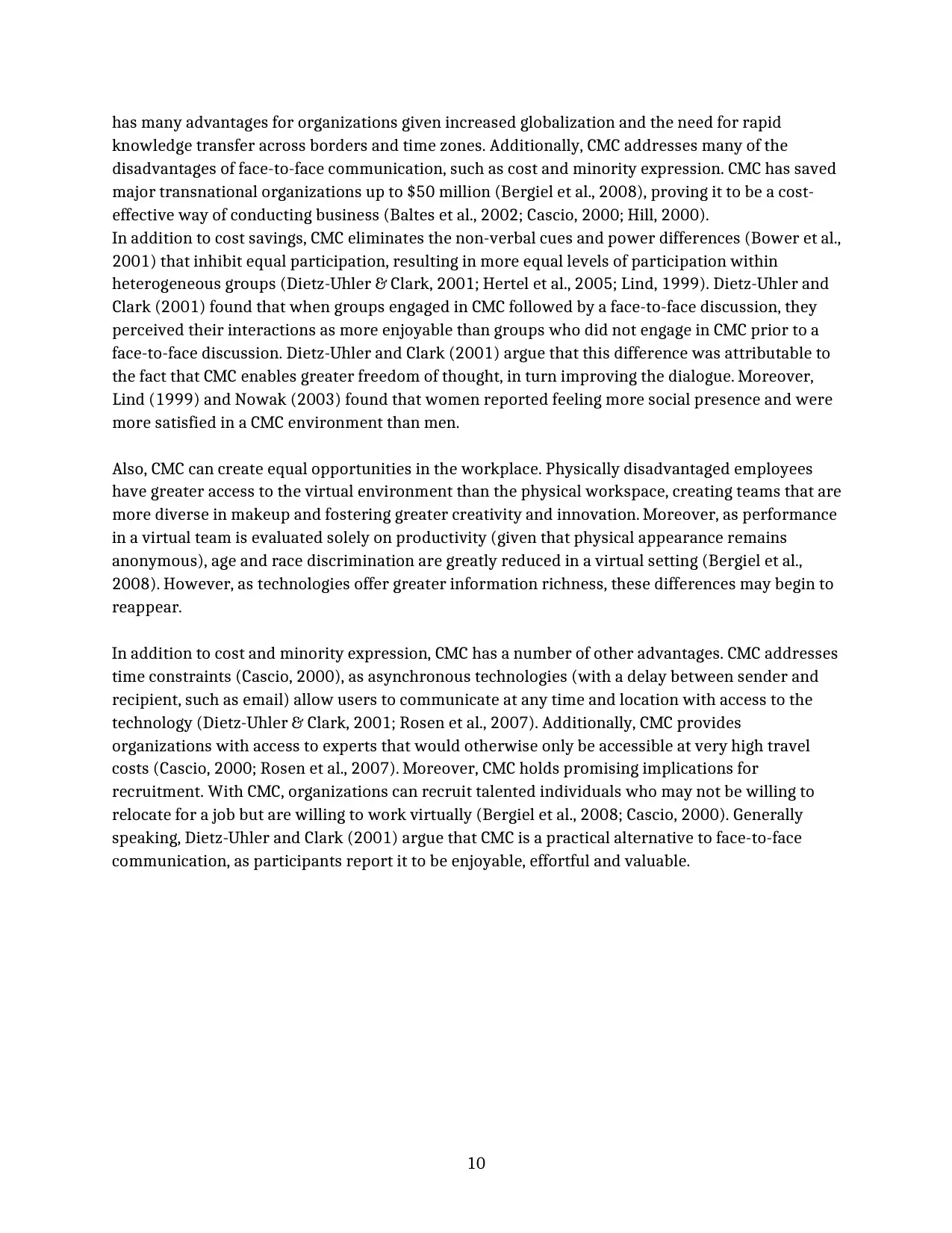
10
has many advantages for organizations given increased globalization and the need for rapid
knowledge transfer across borders and time zones. Additionally, CMC addresses many of the
disadvantages of face-to-face communication, such as cost and minority expression. CMC has saved
major transnational organizations up to $50 million (Bergiel et al., 2008), proving it to be a cost-
effective way of conducting business (Baltes et al., 2002; Cascio, 2000; Hill, 2000).
In addition to cost savings, CMC eliminates the non-verbal cues and power differences (Bower et al.,
2001) that inhibit equal participation, resulting in more equal levels of participation within
heterogeneous groups (Dietz-Uhler & Clark, 2001; Hertel et al., 2005; Lind, 1999). Dietz-Uhler and
Clark (2001) found that when groups engaged in CMC followed by a face-to-face discussion, they
perceived their interactions as more enjoyable than groups who did not engage in CMC prior to a
face-to-face discussion. Dietz-Uhler and Clark (2001) argue that this difference was attributable to
the fact that CMC enables greater freedom of thought, in turn improving the dialogue. Moreover,
Lind (1999) and Nowak (2003) found that women reported feeling more social presence and were
more satisfied in a CMC environment than men.
Also, CMC can create equal opportunities in the workplace. Physically disadvantaged employees
have greater access to the virtual environment than the physical workspace, creating teams that are
more diverse in makeup and fostering greater creativity and innovation. Moreover, as performance
in a virtual team is evaluated solely on productivity (given that physical appearance remains
anonymous), age and race discrimination are greatly reduced in a virtual setting (Bergiel et al.,
2008). However, as technologies offer greater information richness, these differences may begin to
reappear.
In addition to cost and minority expression, CMC has a number of other advantages. CMC addresses
time constraints (Cascio, 2000), as asynchronous technologies (with a delay between sender and
recipient, such as email) allow users to communicate at any time and location with access to the
technology (Dietz-Uhler & Clark, 2001; Rosen et al., 2007). Additionally, CMC provides
organizations with access to experts that would otherwise only be accessible at very high travel
costs (Cascio, 2000; Rosen et al., 2007). Moreover, CMC holds promising implications for
recruitment. With CMC, organizations can recruit talented individuals who may not be willing to
relocate for a job but are willing to work virtually (Bergiel et al., 2008; Cascio, 2000). Generally
speaking, Dietz-Uhler and Clark (2001) argue that CMC is a practical alternative to face-to-face
communication, as participants report it to be enjoyable, effortful and valuable.
has many advantages for organizations given increased globalization and the need for rapid
knowledge transfer across borders and time zones. Additionally, CMC addresses many of the
disadvantages of face-to-face communication, such as cost and minority expression. CMC has saved
major transnational organizations up to $50 million (Bergiel et al., 2008), proving it to be a cost-
effective way of conducting business (Baltes et al., 2002; Cascio, 2000; Hill, 2000).
In addition to cost savings, CMC eliminates the non-verbal cues and power differences (Bower et al.,
2001) that inhibit equal participation, resulting in more equal levels of participation within
heterogeneous groups (Dietz-Uhler & Clark, 2001; Hertel et al., 2005; Lind, 1999). Dietz-Uhler and
Clark (2001) found that when groups engaged in CMC followed by a face-to-face discussion, they
perceived their interactions as more enjoyable than groups who did not engage in CMC prior to a
face-to-face discussion. Dietz-Uhler and Clark (2001) argue that this difference was attributable to
the fact that CMC enables greater freedom of thought, in turn improving the dialogue. Moreover,
Lind (1999) and Nowak (2003) found that women reported feeling more social presence and were
more satisfied in a CMC environment than men.
Also, CMC can create equal opportunities in the workplace. Physically disadvantaged employees
have greater access to the virtual environment than the physical workspace, creating teams that are
more diverse in makeup and fostering greater creativity and innovation. Moreover, as performance
in a virtual team is evaluated solely on productivity (given that physical appearance remains
anonymous), age and race discrimination are greatly reduced in a virtual setting (Bergiel et al.,
2008). However, as technologies offer greater information richness, these differences may begin to
reappear.
In addition to cost and minority expression, CMC has a number of other advantages. CMC addresses
time constraints (Cascio, 2000), as asynchronous technologies (with a delay between sender and
recipient, such as email) allow users to communicate at any time and location with access to the
technology (Dietz-Uhler & Clark, 2001; Rosen et al., 2007). Additionally, CMC provides
organizations with access to experts that would otherwise only be accessible at very high travel
costs (Cascio, 2000; Rosen et al., 2007). Moreover, CMC holds promising implications for
recruitment. With CMC, organizations can recruit talented individuals who may not be willing to
relocate for a job but are willing to work virtually (Bergiel et al., 2008; Cascio, 2000). Generally
speaking, Dietz-Uhler and Clark (2001) argue that CMC is a practical alternative to face-to-face
communication, as participants report it to be enjoyable, effortful and valuable.
Paraphrase This Document
Need a fresh take? Get an instant paraphrase of this document with our AI Paraphraser
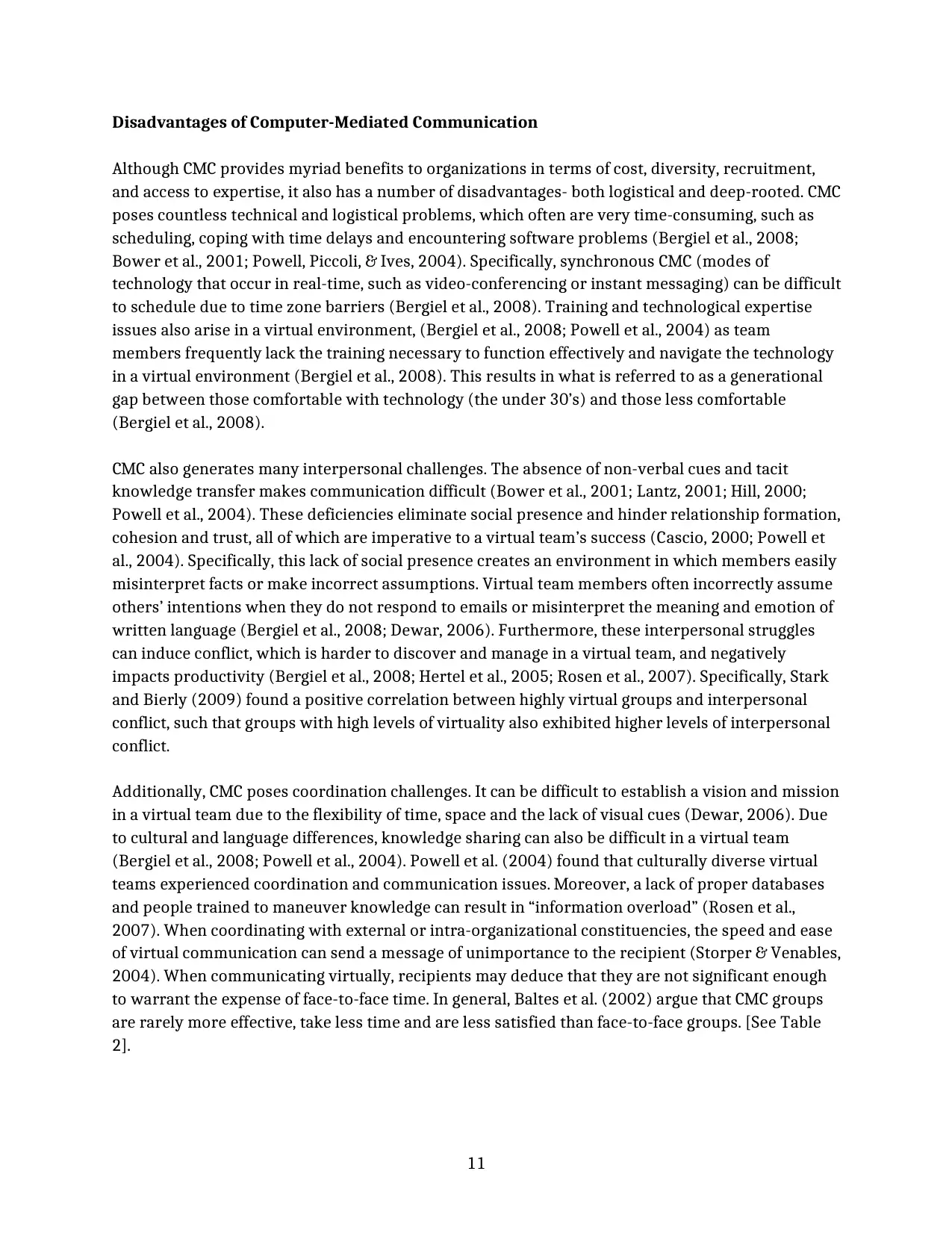
11
Disadvantages of Computer-Mediated Communication
Although CMC provides myriad benefits to organizations in terms of cost, diversity, recruitment,
and access to expertise, it also has a number of disadvantages- both logistical and deep-rooted. CMC
poses countless technical and logistical problems, which often are very time-consuming, such as
scheduling, coping with time delays and encountering software problems (Bergiel et al., 2008;
Bower et al., 2001; Powell, Piccoli, & Ives, 2004). Specifically, synchronous CMC (modes of
technology that occur in real-time, such as video-conferencing or instant messaging) can be difficult
to schedule due to time zone barriers (Bergiel et al., 2008). Training and technological expertise
issues also arise in a virtual environment, (Bergiel et al., 2008; Powell et al., 2004) as team
members frequently lack the training necessary to function effectively and navigate the technology
in a virtual environment (Bergiel et al., 2008). This results in what is referred to as a generational
gap between those comfortable with technology (the under 30’s) and those less comfortable
(Bergiel et al., 2008).
CMC also generates many interpersonal challenges. The absence of non-verbal cues and tacit
knowledge transfer makes communication difficult (Bower et al., 2001; Lantz, 2001; Hill, 2000;
Powell et al., 2004). These deficiencies eliminate social presence and hinder relationship formation,
cohesion and trust, all of which are imperative to a virtual team’s success (Cascio, 2000; Powell et
al., 2004). Specifically, this lack of social presence creates an environment in which members easily
misinterpret facts or make incorrect assumptions. Virtual team members often incorrectly assume
others’ intentions when they do not respond to emails or misinterpret the meaning and emotion of
written language (Bergiel et al., 2008; Dewar, 2006). Furthermore, these interpersonal struggles
can induce conflict, which is harder to discover and manage in a virtual team, and negatively
impacts productivity (Bergiel et al., 2008; Hertel et al., 2005; Rosen et al., 2007). Specifically, Stark
and Bierly (2009) found a positive correlation between highly virtual groups and interpersonal
conflict, such that groups with high levels of virtuality also exhibited higher levels of interpersonal
conflict.
Additionally, CMC poses coordination challenges. It can be difficult to establish a vision and mission
in a virtual team due to the flexibility of time, space and the lack of visual cues (Dewar, 2006). Due
to cultural and language differences, knowledge sharing can also be difficult in a virtual team
(Bergiel et al., 2008; Powell et al., 2004). Powell et al. (2004) found that culturally diverse virtual
teams experienced coordination and communication issues. Moreover, a lack of proper databases
and people trained to maneuver knowledge can result in “information overload” (Rosen et al.,
2007). When coordinating with external or intra-organizational constituencies, the speed and ease
of virtual communication can send a message of unimportance to the recipient (Storper & Venables,
2004). When communicating virtually, recipients may deduce that they are not significant enough
to warrant the expense of face-to-face time. In general, Baltes et al. (2002) argue that CMC groups
are rarely more effective, take less time and are less satisfied than face-to-face groups. [See Table
2].
Disadvantages of Computer-Mediated Communication
Although CMC provides myriad benefits to organizations in terms of cost, diversity, recruitment,
and access to expertise, it also has a number of disadvantages- both logistical and deep-rooted. CMC
poses countless technical and logistical problems, which often are very time-consuming, such as
scheduling, coping with time delays and encountering software problems (Bergiel et al., 2008;
Bower et al., 2001; Powell, Piccoli, & Ives, 2004). Specifically, synchronous CMC (modes of
technology that occur in real-time, such as video-conferencing or instant messaging) can be difficult
to schedule due to time zone barriers (Bergiel et al., 2008). Training and technological expertise
issues also arise in a virtual environment, (Bergiel et al., 2008; Powell et al., 2004) as team
members frequently lack the training necessary to function effectively and navigate the technology
in a virtual environment (Bergiel et al., 2008). This results in what is referred to as a generational
gap between those comfortable with technology (the under 30’s) and those less comfortable
(Bergiel et al., 2008).
CMC also generates many interpersonal challenges. The absence of non-verbal cues and tacit
knowledge transfer makes communication difficult (Bower et al., 2001; Lantz, 2001; Hill, 2000;
Powell et al., 2004). These deficiencies eliminate social presence and hinder relationship formation,
cohesion and trust, all of which are imperative to a virtual team’s success (Cascio, 2000; Powell et
al., 2004). Specifically, this lack of social presence creates an environment in which members easily
misinterpret facts or make incorrect assumptions. Virtual team members often incorrectly assume
others’ intentions when they do not respond to emails or misinterpret the meaning and emotion of
written language (Bergiel et al., 2008; Dewar, 2006). Furthermore, these interpersonal struggles
can induce conflict, which is harder to discover and manage in a virtual team, and negatively
impacts productivity (Bergiel et al., 2008; Hertel et al., 2005; Rosen et al., 2007). Specifically, Stark
and Bierly (2009) found a positive correlation between highly virtual groups and interpersonal
conflict, such that groups with high levels of virtuality also exhibited higher levels of interpersonal
conflict.
Additionally, CMC poses coordination challenges. It can be difficult to establish a vision and mission
in a virtual team due to the flexibility of time, space and the lack of visual cues (Dewar, 2006). Due
to cultural and language differences, knowledge sharing can also be difficult in a virtual team
(Bergiel et al., 2008; Powell et al., 2004). Powell et al. (2004) found that culturally diverse virtual
teams experienced coordination and communication issues. Moreover, a lack of proper databases
and people trained to maneuver knowledge can result in “information overload” (Rosen et al.,
2007). When coordinating with external or intra-organizational constituencies, the speed and ease
of virtual communication can send a message of unimportance to the recipient (Storper & Venables,
2004). When communicating virtually, recipients may deduce that they are not significant enough
to warrant the expense of face-to-face time. In general, Baltes et al. (2002) argue that CMC groups
are rarely more effective, take less time and are less satisfied than face-to-face groups. [See Table
2].
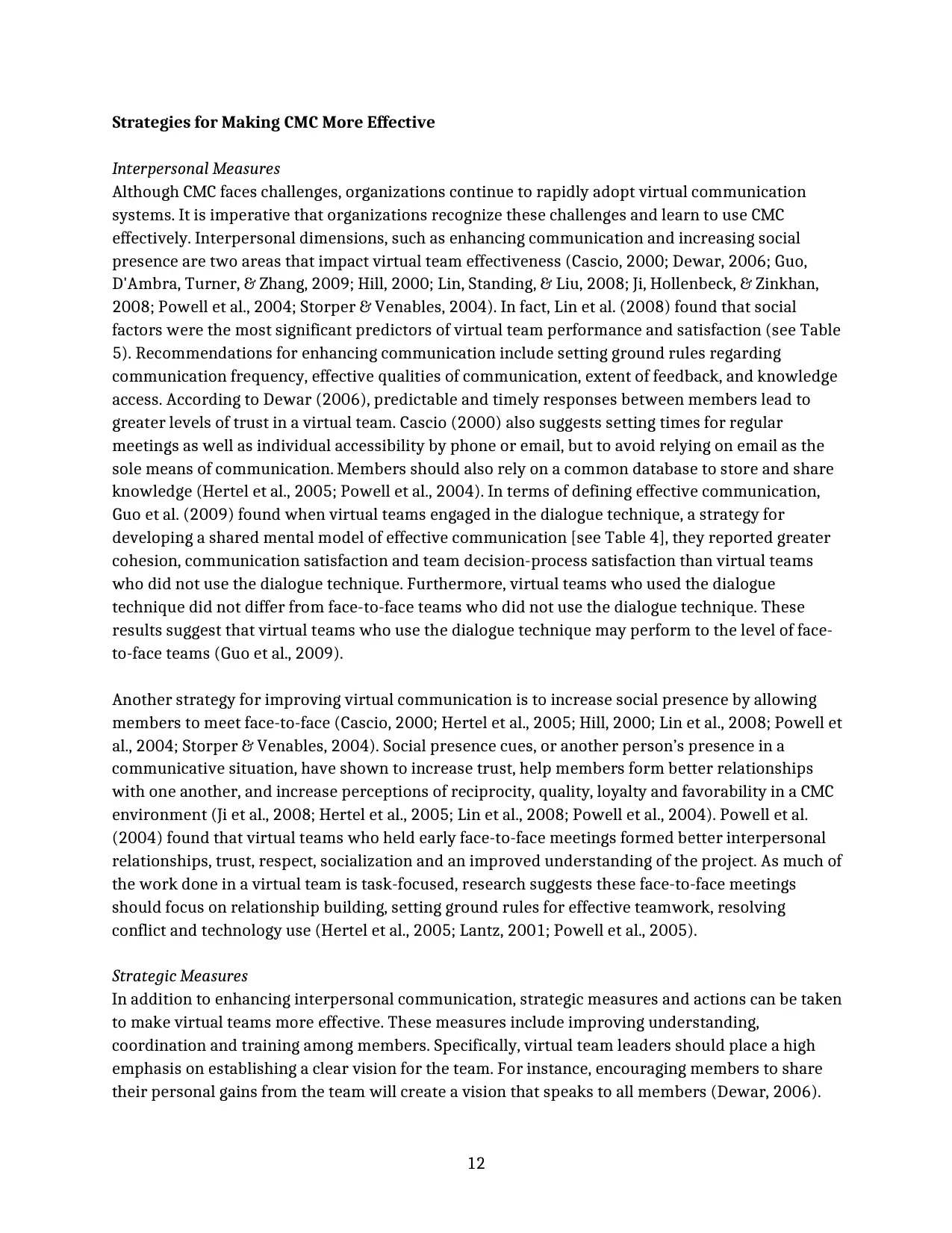
12
Strategies for Making CMC More Effective
Interpersonal Measures
Although CMC faces challenges, organizations continue to rapidly adopt virtual communication
systems. It is imperative that organizations recognize these challenges and learn to use CMC
effectively. Interpersonal dimensions, such as enhancing communication and increasing social
presence are two areas that impact virtual team effectiveness (Cascio, 2000; Dewar, 2006; Guo,
D'Ambra, Turner, & Zhang, 2009; Hill, 2000; Lin, Standing, & Liu, 2008; Ji, Hollenbeck, & Zinkhan,
2008; Powell et al., 2004; Storper & Venables, 2004). In fact, Lin et al. (2008) found that social
factors were the most significant predictors of virtual team performance and satisfaction (see Table
5). Recommendations for enhancing communication include setting ground rules regarding
communication frequency, effective qualities of communication, extent of feedback, and knowledge
access. According to Dewar (2006), predictable and timely responses between members lead to
greater levels of trust in a virtual team. Cascio (2000) also suggests setting times for regular
meetings as well as individual accessibility by phone or email, but to avoid relying on email as the
sole means of communication. Members should also rely on a common database to store and share
knowledge (Hertel et al., 2005; Powell et al., 2004). In terms of defining effective communication,
Guo et al. (2009) found when virtual teams engaged in the dialogue technique, a strategy for
developing a shared mental model of effective communication [see Table 4], they reported greater
cohesion, communication satisfaction and team decision-process satisfaction than virtual teams
who did not use the dialogue technique. Furthermore, virtual teams who used the dialogue
technique did not differ from face-to-face teams who did not use the dialogue technique. These
results suggest that virtual teams who use the dialogue technique may perform to the level of face-
to-face teams (Guo et al., 2009).
Another strategy for improving virtual communication is to increase social presence by allowing
members to meet face-to-face (Cascio, 2000; Hertel et al., 2005; Hill, 2000; Lin et al., 2008; Powell et
al., 2004; Storper & Venables, 2004). Social presence cues, or another person’s presence in a
communicative situation, have shown to increase trust, help members form better relationships
with one another, and increase perceptions of reciprocity, quality, loyalty and favorability in a CMC
environment (Ji et al., 2008; Hertel et al., 2005; Lin et al., 2008; Powell et al., 2004). Powell et al.
(2004) found that virtual teams who held early face-to-face meetings formed better interpersonal
relationships, trust, respect, socialization and an improved understanding of the project. As much of
the work done in a virtual team is task-focused, research suggests these face-to-face meetings
should focus on relationship building, setting ground rules for effective teamwork, resolving
conflict and technology use (Hertel et al., 2005; Lantz, 2001; Powell et al., 2005).
Strategic Measures
In addition to enhancing interpersonal communication, strategic measures and actions can be taken
to make virtual teams more effective. These measures include improving understanding,
coordination and training among members. Specifically, virtual team leaders should place a high
emphasis on establishing a clear vision for the team. For instance, encouraging members to share
their personal gains from the team will create a vision that speaks to all members (Dewar, 2006).
Strategies for Making CMC More Effective
Interpersonal Measures
Although CMC faces challenges, organizations continue to rapidly adopt virtual communication
systems. It is imperative that organizations recognize these challenges and learn to use CMC
effectively. Interpersonal dimensions, such as enhancing communication and increasing social
presence are two areas that impact virtual team effectiveness (Cascio, 2000; Dewar, 2006; Guo,
D'Ambra, Turner, & Zhang, 2009; Hill, 2000; Lin, Standing, & Liu, 2008; Ji, Hollenbeck, & Zinkhan,
2008; Powell et al., 2004; Storper & Venables, 2004). In fact, Lin et al. (2008) found that social
factors were the most significant predictors of virtual team performance and satisfaction (see Table
5). Recommendations for enhancing communication include setting ground rules regarding
communication frequency, effective qualities of communication, extent of feedback, and knowledge
access. According to Dewar (2006), predictable and timely responses between members lead to
greater levels of trust in a virtual team. Cascio (2000) also suggests setting times for regular
meetings as well as individual accessibility by phone or email, but to avoid relying on email as the
sole means of communication. Members should also rely on a common database to store and share
knowledge (Hertel et al., 2005; Powell et al., 2004). In terms of defining effective communication,
Guo et al. (2009) found when virtual teams engaged in the dialogue technique, a strategy for
developing a shared mental model of effective communication [see Table 4], they reported greater
cohesion, communication satisfaction and team decision-process satisfaction than virtual teams
who did not use the dialogue technique. Furthermore, virtual teams who used the dialogue
technique did not differ from face-to-face teams who did not use the dialogue technique. These
results suggest that virtual teams who use the dialogue technique may perform to the level of face-
to-face teams (Guo et al., 2009).
Another strategy for improving virtual communication is to increase social presence by allowing
members to meet face-to-face (Cascio, 2000; Hertel et al., 2005; Hill, 2000; Lin et al., 2008; Powell et
al., 2004; Storper & Venables, 2004). Social presence cues, or another person’s presence in a
communicative situation, have shown to increase trust, help members form better relationships
with one another, and increase perceptions of reciprocity, quality, loyalty and favorability in a CMC
environment (Ji et al., 2008; Hertel et al., 2005; Lin et al., 2008; Powell et al., 2004). Powell et al.
(2004) found that virtual teams who held early face-to-face meetings formed better interpersonal
relationships, trust, respect, socialization and an improved understanding of the project. As much of
the work done in a virtual team is task-focused, research suggests these face-to-face meetings
should focus on relationship building, setting ground rules for effective teamwork, resolving
conflict and technology use (Hertel et al., 2005; Lantz, 2001; Powell et al., 2005).
Strategic Measures
In addition to enhancing interpersonal communication, strategic measures and actions can be taken
to make virtual teams more effective. These measures include improving understanding,
coordination and training among members. Specifically, virtual team leaders should place a high
emphasis on establishing a clear vision for the team. For instance, encouraging members to share
their personal gains from the team will create a vision that speaks to all members (Dewar, 2006).
⊘ This is a preview!⊘
Do you want full access?
Subscribe today to unlock all pages.

Trusted by 1+ million students worldwide
1 out of 100
Your All-in-One AI-Powered Toolkit for Academic Success.
+13062052269
info@desklib.com
Available 24*7 on WhatsApp / Email
![[object Object]](/_next/static/media/star-bottom.7253800d.svg)
Unlock your academic potential
Copyright © 2020–2025 A2Z Services. All Rights Reserved. Developed and managed by ZUCOL.